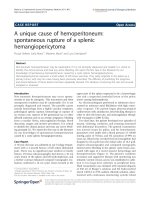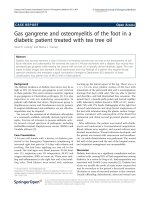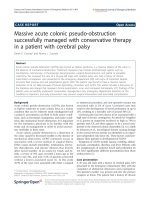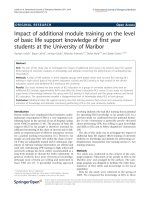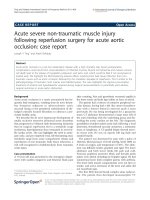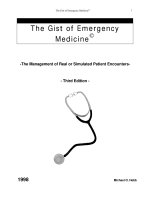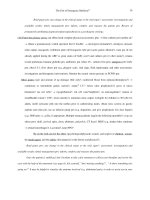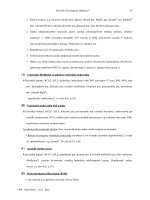- Trang chủ >>
- Y - Dược >>
- Ngoại khoa
oxford handook of emergency medicine 4th ed
Bạn đang xem bản rút gọn của tài liệu. Xem và tải ngay bản đầy đủ của tài liệu tại đây (4.69 MB, 770 trang )
OXFORD MEDICAL PUBLICATIONS
Oxford Handbook of
Emergency
Medicine
Published and forthcoming Oxford Handbooks
Oxford Handbook for the Foundation Programme 3e
Oxford Handbook of Acute Medicine 3e
Oxford Handbook of Anaesthesia 3e
Oxford Handbook of Applied Dental Sciences
Oxford Handbook of Cardiology 2e
Oxford Handbook of Clinical and Laboratory Investigation 3e
Oxford Handbook of Clinical Dentistry 5e
Oxford Handbook of Clinical Diagnosis 2e
Oxford Handbook of Clinical Examination and Practical Skills
Oxford Handbook of Clinical Haematology 3e
Oxford Handbook of Clinical Immunology and Allergy 2e
Oxford Handbook of Clinical Medicine - Mini Edition 8e
Oxford Handbook of Clinical Medicine 8e
Oxford Handbook of Clinical Pharmacy
Oxford Handbook of Clinical Rehabilitation 2e
Oxford Handbook of Clinical Specialties 8e
Oxford Handbook of Clinical Surgery 3e
Oxford Handbook of Complementary Medicine
Oxford Handbook of Critical Care 3e
Oxford Handbook of Dental Patient Care 2e
Oxford Handbook of Dialysis 3e
Oxford Handbook of Emergency Medicine 4e
Oxford Handbook of Endocrinology and Diabetes 2e
Oxford Handbook of ENT and Head and Neck Surgery
Oxford Handbook of Expedition and Wilderness Medicine
Oxford Handbook of Forensic Medicine
Oxford Handbook of Gastroenterology & Hepatology 2e
Oxford Handbook of General Practice 3e
Oxford Handbook of Genetics
Oxford Handbook of Genitourinary Medicine, HIV and AIDS 2e
Oxford Handbook of Geriatric Medicine
Oxford Handbook of Infectious Diseases and Microbiology
Oxford Handbook of Key Clinical Evidence
Oxford Handbook of Medical Dermatology
Oxford Handbook of Medical Sciences
Oxford Handbook of Medical Statistics
Oxford Handbook of Nephrology and Hypertension
Oxford Handbook of Neurology
Oxford Handbook of Nutrition and Dietetics
Oxford Handbook of Obstetrics and Gynaecology 2e
Oxford Handbook of Occupational Health
Oxford Handbook of Oncology 3e
Oxford Handbook of Ophthalmology 2e
Oxford Handbook of Paediatrics
Oxford Handbook of Pain Management
Oxford Handbook of Palliative Care 2e
Oxford Handbook of Practical Drug Therapy 2e
Oxford Handbook of Pre-Hospital Care
Oxford Handbook of Psychiatry 2e
Oxford Handbook of Public Health Practice 2e
Oxford Handbook of Reproductive Medicine & Family Planning
Oxford Handbook of Respiratory Medicine 2e
Oxford Handbook of Rheumatology 3e
Oxford Handbook of Sport and Exercise Medicine
Oxford Handbook of Tropical Medicine 3e
Oxford Handbook of Urology 2e
Oxford Handbook of
Emergency
Medicine
Fourth edition
Jonathan P. Wyatt
Consultant in Emergency Medicine and
Forensic Physician
Royal Cornwall Hospital, Truro, UK
Robin N. Illingworth
Consultant in Emergency Medicine
St James’s University Hospital, Leeds, UK
Colin A. Graham
Professor of Emergency Medicine
Chinese University of Hong Kong,
Hong Kong SAR, China
Kerstin Hogg
Clinical Research Fellow,
The Ottawa Hospital, Ottawa, Canada
with senior international advisors:
Michael J. Clancy
Consultant in Emergency Medicine
Southampton General Hospital,
Southampton, UK
Colin E. Robertson
Professor of Emergency Medicine
Royal Infi rmary, Edinburgh, UK
1
1
Great Clarendon Street, Oxford OX2 6DP
Oxford University Press is a department of the University of Oxford.
It furthers the University’s objective of excellence in research, scholarship,
and education by publishing worldwide in
Oxford New York
Auckland Cape Town Dar es Salaam Hong Kong Karachi
Kuala Lumpur Madrid Melbourne Mexico City Nairobi
New Delhi Shanghai Taipei Toronto
With offi ces in
Argentina Austria Brazil Chile Czech Republic France Greece
Guatemala Hungary Italy Japan Poland Portugal Singapore
South Korea Switzerland Thailand Turkey Ukraine Vietnam
Oxford is a registered trade mark of Oxford University Press
in the UK and in certain other countries
Published in the United States
by Oxford University Press Inc., New York
© Oxford University Press, 2012
The moral rights of the authors have been asserted
Database right Oxford University Press (maker)
First edition published 1999
Second edition published 2005
Third edition published 2006
Fourth edition published 2012
All rights reserved. No part of this publication may be reproduced,
stored in a retrieval system, or transmitted, in any form or by any means,
without the prior permission in writing of Oxford University Press,
or as expressly permitted by law, or under terms agreed with the appropriate
reprographics rights organization. Enquiries concerning reproduction
outside the scope of the above should be sent to the Rights Department,
Oxford University Press, at the address above
You must not circulate this book in any other binding or cover
and you must impose this same condition on any acquirer
British Library Cataloguing in Publication Data
Data available
Library of Congress Cataloging-in-Publication-Data
Data available
Typeset by Cenveo, Bangalore, India
Printed in Italy
on acid-free paper by
L.E.G.O. S.p.A.—Lavis TN
ISBN 978–0–19–958956–2
10 9 8 7 6 5 4 3 2 1
Oxford University Press makes no representation, express or implied, that the
drug dosages in this book are correct. Readers must therefore always check the
product information and clinical procedures with the most up-to-date published
product information and data sheets provided by the manufacturers and the most
recent codes of conduct and safety regulations. The authors and publishers do not
accept responsibility or legal liability for any errors in the text or for the misuse or
misapplication of material in this work. Except where otherwise stated, drug dosages
and recommendations are for the non-pregnant adult who is not breastfeeding.
Dedicated to Dr Robin Mitchell (1964–2010)
Emergency Physician in Christchurch, Edinburgh and Auckland.
Outstanding clinician and teacher, tremendous colleague and friend.
This page intentionally left blank
vii
Abbreviations and symbols
ix
Normal values xvii
Acknowledgements xix
1 General approach
1
2 Life-threatening emergencies
41
3 Medicine
62
4 Toxicology
179
5 Infectious diseases
219
6 Environmental emergencies
253
7 Analgesia and anaesthesia
271
8 Major trauma
319
9 Wounds, fractures, orthopaedics
401
10 Surgery
503
11 Ophthalmology
533
12 Ear, nose and throat
545
13 Obstetrics and gynaecology
563
14 Psychiatry
601
15 Paediatric emergencies
630
Index
737
Contents
This page intentionally left blank
ix
° degrees
8 approximately
+ve positive
–ve negative
± plus or minus
i increase(d)
d decrease(d)
ABC airway, breathing, circulation
ABG arterial blood gas
AC acromio-clavicular
ACE angiotensin-converting enzyme
ACTH adrenocorticotropic hormone
ACS acute coronary syndrome
AF atrial fi brillation
AIDS acquired immune defi ciency syndrome
AIO Ambulance incident offi cer
AIS abbreviated injury scale
ALS advanced life support
ALT alanine aminotransferase
ALTE apparently life-threatening event
AP antero-posterior
APLS Advanced Paediatric Life Support
APTT activated partial thromboplastin time
ARDS adult respiratory distress syndrome
ARF acute renal failure
AST aspartate transaminase
ATLS advanced trauma life support
AV atrio-ventricular
bd twice daily
BKPOP below knee Plaster of Paris
BKWPOP below knee walking Plaster of Paris
BLS basic life support
BMG bedside strip measurement of venous/capillary blood glucose
BNF British National Formulary
BNFC British National Formulary for Children
Abbreviations and symbols
x
ABBREVIATIONS AND SYMBOLS
BP blood pressure
BTS British Thoracic Society
BZP benzylpiperazine
CBRN chemical, biological, radiological, nuclear
CCU critical care unit
CK creatine kinase
cm centimetre(s)
CMV cytomegalovirus
CN chloroacetophenone
CNS central nervous system
CO carbon monoxide
CO
2
carbon dioxide
COHb carboxyhaemoglobin
COPD chronic obstructive pulmonary disease
CPAP continuous positive airways pressure
CPR cardiopulmonary resuscitation
CRF chronic renal failure
CRP C-reactive protein
CSF cerebrospinal fl uid
CT computed tomography
CTPA computed tomography pulmonary angiography
CVP central venous pressure
CVS cardiovascular system
CXR chest X-ray
DIC disseminated intravascular coagulation
DIPJ distal interphalangeal joint
DKA diabetic ketoacidosis
dL decilitre
DPL diagnostic peritoneal lavage
DPT diphtheria, pertussis, and tetanus
DSH deliberate self-harm
DVT deep venous thrombosis
EBV Epstein–Barr virus
ECG electrocardiogram
ECT electroconvulsive therapy
ED emergency department
EEG electroencephalogram
EMLA eutectic mixture of local anaesthetics
ENT ear, nose and throat
EPAP expiratory positive airway pressure
xi
ABBREVIATIONS AND SYMBOLS
ESR erythrocyte sedimentation rate
ET endotracheal
ETCO
2
end-tidal carbon dioxide
FAST focused assessment with sonography for trauma
FB foreign body
FBC full blood count
FFP fresh frozen plasma
FG French Gauge
FiO
2
inspired oxygen concentration
FOB faecal occult blood
G6-PD glucose 6-phosphate dehydrogenase
g gram(s)
G gauge
GA general anaesthetic
GCS Glasgow Coma Score
GFR glomerular fi ltration rate
GI gastrointestinal
GHB gammahydroxybutyrate
GMC General Medical Council
GP general practitioner
GTN glyceryl trinitrate
GU genitourinary
5HT 5-hydroxytryptamine
HATI human anti-tetanus immunoglobulin
Hb haemoglobin
HCG human chorionic gonadotrophin
HCM hypertrophic cardiomyopathy
Hct haematocrit
HDU high dependency unit
HHS hyperosmolar hyperglycaemic state
HIV human immunodefi ciency virus
HONK hyperosmolar non-ketotic hyperglycaemia
hr hour/s
HTLV human T-cell lymphotropic virus
ICP intracranial pressure
ICU intensive care unit
IDDM insulin dependent diabetes mellitus
IHD ischaemic heart disease
IM intramuscular
INR international normalized ratio (of prothrombin time)
xii
ABBREVIATIONS AND SYMBOLS
IO intra-osseous
IPAP inspiratory positive airway pressure
IPg interphalangeal
IPPV intermittent positive pressure ventilation
ISS injury severity score
ITP idiopathic thrombocytopenic purpura
IUCD intrauterine contraceptive device
IV intravenous
IVI intravenous infusion
IVRA intravenous regional anaesthesia
IVU intravenous urography
JVP jugular venous pressure
KE kinetic energy
kPa kiloPascal(s) pressure
KUB X-ray covering the area of kidneys, ureters and bladder
L litre(s)
LA local anaesthetic
LAD left axis deviation
LBBB left bundle branch block
LDH lactate dehydrogenase
LET lidocaine epinephrine tetracaine
LFTs liver function tests
LMA laryngeal mask airway
LMP last menstrual period
LMWH low molecular weight heparin
LP lumbar puncture
LSD lysergic acid diethylamide
LV left ventricular
LVF left ventricular failure
LVH left venticular hypertrophy
m metre(s)
MAOI monoamine oxidase inhibitor
MAST military anti-shock trousers
max maximum
MC metacarpal
MCA Mental Capacity Act
MCPJ metacarpophalangeal joint
MDU Medical Defence Union
MI myocardial infarction
min minute/s
xiii
ABBREVIATIONS AND SYMBOLS
MIO medical incident offi cer
mL millilitre(s)
mmHg millimetres of mercury pressure
mmol millimoles
MMR mumps, measles, and rubella
MRI magnetic resonance imaging
MRSA meticillin resistant Staphylococcus aureus
MS multiple sclerosis
MSU mid-stream specimen of urine
MT metatarsal
MTPJ metatarsophalangeal joint
MUA manipulation under anaesthetic
NAC N -acetyl cysteine
NAI non-accidental injury
ND notifi able disease
NG nasogastric
NHS National Health Service
NIV non-invasive ventilation
NO nitrous oxide
NSAID non-steroidal anti-infl ammatory drug
NSTEMI non-ST segment elevation myocardial infarction
NWBPOP non-weight-bearing Plaster of Paris
O
2
oxygen
OA osteoarthritis
OCP oral contraceptive pill
od once daily
OPG orthopantomogram
ORIF open reduction and internal fi xation
ORT oral replacement therapy
PA postero-anterior
PACS picture archiving and communication system
PAN polyarteritis nodosa
PCI percutaneous coronary intervention
pCO
2
arterial partial pressure of carbon dioxide
PCR polymerase chain reaction
PE pulmonary embolus
PEA pulseless electrical activity
PEEP positive end-expiratory pressure
PEFR peak expiratory fl ow rate
PGL persistent generalized lymphadenopathy
xiv
ABBREVIATIONS AND SYMBOLS
PICU paediatric intensive care unit
PID pelvic infl ammatory disease
PIPJ proximal interphalangeal joint
PO per os (orally/by mouth)
pO
2
arterial partial pressure of oxygen
POP plaster of Paris
PPE personal protective equipment
PPI proton pump inhibitor
PR per rectum
PRF patient report form
PRN pro re nata (as required)
PSP primary spontaneous pneumothorax
PV per vaginam
qds four times a day
RA rheumatoid arthritis
RAD right axis deviation
RBBB right bundle branch block
RBC red blood cells
Rh Rhesus
ROSC restoration of spontaneous circulation
RR respiratory rate
RSI rapid sequence induction/intubation
RSV respiratory syncytial virus
rtPA recombinant tissue plasminogen activator
RTS revised trauma score
RV right ventricular
SA sino-atrial
SARS severe acute respiratory syndrome
SC subcutaneous
SCIWORA spinal cord injury without radiographic abnormality
sec second(s)
SIDS sudden infant death syndrome
SIGN Scottish Intercollegiate Guidelines Network
SIRS systemic infl ammatory response syndrome
SL sublingual
SLE systemic lupus erythematosus
SpO
2
arterial oxygen saturation
SSP secondary spontaneous pneumothorax
SSRI selective serotonin re-uptake inhibitor
STD sexually transmitted disease
xv
ABBREVIATIONS AND SYMBOLS
STEMI ST segment elevation myocardial infarction
SVT supraventricular tachycardia
T ° temperature
T
3
tri-iodothyronine
T
4
thyroxine
TAC tetracaine, adrenaline and cocaine
TB tuberculosis
tds three times a day
TFTs thyroid function tests
TIA transient ischaemic attack
TIMI thrombolysis in myocardial infarction
tPA tissue plasminogen actvator
TSH thyroid stimulating hormone
u/U unit(s)
U&E urea and electrolytes
URTI upper respiratory tract infection
USS ultrasound scan
UTI urinary tract infection
V volts
VA visual acuity
VF ventricular fi brillation
VHF viral hemorrhagic fever
V/Q ventilation/perfusion (scan)
VT ventricular tachycardia
WB weight-bear(ing)
WBC white blood cells
WCC white cell count
WHO World Health Organization
WPW Wolff Parkinson White (syndrome)
This page intentionally left blank
xvii
Note that ‘normal’ values in adults may vary slightly between labs.
Normal values in pregnancy are shown in b The pregnant patient, p.576.
Arterial blood gas analysis
Biochemistry
Normal values
H
+
35–45 nanomol/L
pH 7.35–7.45
pO
2
(on air) >10.6 kPa, 75–100 mmHg
pCO
2
4.5–6.0 kPa, 35–45 mmHg
bicarbonate 24–28 mmol/L
base excess
± 2 mmol/L
alanine aminotransferase (ALT) 5–35 iu/L
albumin 35–50 g/L
alkaline phosphatase 30–300 iu/L
amylase 0–180 Somogyi U/dL
aspartate transaminase (AST) 5–35 iu/L
bicarbonate 24–30 mmol/L
bilirubin 3–17 micromol/L
calcium (total) 2.12–2.65 mmol/L
calcium (ionized) 1–1.25 mmol/L
chloride 95–105 mmol/L
creatine kinase (CK) 25–195 iu/L
creatinine 70–150 micromol/L
C-reactive protein (CRP) <10 mg/L
glucose (fasting) 3.5–5.5 mmol/L
G glutamyl transpeptidase (4)
11–51 IU/L
(5)
7–33 IU/L
magnesium 0.75–1.05 mmol/L
osmolality 278–305 mosmol/kg
potassium 3.5–5.0 mmol/L
sodium 135–145 mmol/L
urea 2.5–6.7 mmol/L
urate (5)
150–390 micromol/L
(4)
210–480 micromol/L
xviii
NORMAL VALUES
Haematology
Metric conversion
Length
Weight
Volume
1 L = 1.76 UK pints = 2.11 US liquid pints
1 UK pint = 20 fl uid ounces = 0.568 L
1 US liquid pint = 16 fl uid ounces = 0.473 L
1 teaspoon 8 5mL
1 tablespoon 8 15mL
Temperature
T ° in °C = ( T ° in Fahrenheit – 32) ×
9
5
–
Pressure
1kPa = 7.5mmHg
RBC (women)
3.9–5.6 × 10
12
/L
(men)
4.5–6.5 × 10
12
/L
Hb (women) 11.5–16.0g/dL
(men) 13.5–18.0g/dL
Hct (women) 0.37–0.47
(men) 0.40–0.54
MCV 76–96 femtoL
WCC
4.0–11.0 × 10
9
/L
neutrophils
2.0–7.5 × 10
9
/L (40–75 % of WCC)
lymphocytes
1.5–4.0 × 10
9
/L (20–40 % of WCC)
monocytes
0.2–0.8 × 10
9
/L (2–10 % of WCC)
eosinophils
0.04–0.40 × 10
9
/L (1–6 % of WCC)
basophils
<0.1 × 10
9
/L (<1 % of WCC)
platelets
150–400 × 10
9
/L
prothrombin time
(factors I, II, VII, X) 12–15sec
APTT (factors VII,
IX, XI, XII) 23–42sec
International Normalized Ratio (INR) therapeutic targets
2.0–3.0 (for treating DVT, pulmonary embolism)
2.5–3.5 (embolism prophylaxis for AF)
3.0–4.5 (recurrent thrombo-embolic disease,
arterial grafts & prosthetic valves)
ESR (women) <
(age in years+10)
/
2
mm/hr
(men) <
(age in years)
/
2
mm/hr
1m = 3 feet 3.4 inches 1 foot = 0.3048m
1cm = 0.394 inch 1 inch = 25.4mm
1kg = 2.20 pounds 1 stone = 6.35kg
1g = 15.4 grains 1 pound = 0.454kg
1 ounce = 28.4g
xix
A number of people provided comments, help and moral support. Special
thanks are due to Dr Phil Munro. We also wish to thank:
Miss Sehlah Abassi, Mr David Alao, Dr Matt Baker, Dr Joan Barber, Dr Ruth
Beach, Mr Dewald Behrens, Dr Ash Bhatia, Dr Angela Bonnar, Dr Rachel
Broadley, Dr Chris Brown, Mrs Debra Clayton, Mr Jon Davies, Dr Kate
Evans, Dr James Falconer, Miss Paula Fitzpatrick, Mrs Jennifer Flemen,
Dr Adrian Flynn, Dr Debbie Galbraith, Mr Blair Graham, Dr Catherine
Guly, Mr Chris Hadfi eld, Dr Steve Halford, Mr Andrew Harrower, Miss
Emily Hotton, Mr Jim Huntley, Mrs Eileen Hutchison, Mr Nicholas Hyatt,
Dr Karen Illingworth, Mr Ian Kelly, Mr Jacques Kerr, Dr Alastair Kidd,
Dr Paul Leonard, Mr Malcolm Lewis, Mr AF Mabrook, Dr Simon Mardel,
Dr Nick Mathiew, Ms Carolyn Meikle, Dr Louisa Mitchell, Dr Claudia
Murton, Dr Louisa Pieterse, Dr Stephanie Prince, Dr Laura Robertson, Miss
Katharine Robinson, Dr Andrew Sampson, Mr Tom Scott, Dr Simon Scott-
Hayward, Ms Karen Sim, Mr Toby Slade, Dr Timothy Squires, Mr Ashleigh
Stone, Dr Luke Summers, Dr Rob Taylor, Dr Ross Vanstone, Ms Fiona
Wardlaw, Dr Mike Wells, Mr Ken Woodburn, Mrs Polly Wyatt.
Acknowledgements
This page intentionally left blank
1
The emergency department 2
Note keeping 4
Radiological requests 6
Triage 7
Discharge, referral, and handover 8
Liaising with GPs 10
Telephone advice 11
Liaising with the ambulance crew 12
Coping as a junior doctor 14
Inappropriate attenders 16
The patient with a label 17
The patient you dislike 18
Special patient groups 19
Discharging the elderly patient 20
The patient with learning diffi culties 21
Patient transfer 22
Breaking bad news 24
What to do after a death 26
Medicolegal aspects: avoiding trouble 28
Medicolegal aspects: the law 30
Infection control and prevention 32
What to carry in your car 34
At the roadside 36
Major incidents 38
General approach
Chapter 1
2 CHAPTER 1 General approach
The emergency department
The role of the emergency department
The emergency department (ED) occupies a key position in terms of the
interface between primary and secondary care. It has a high public profi le.
Many patients attend without referral, but some are referred by NHS
Direct, minor injury units, general practitioners (GPs), and other medical
practitioners. The ED manages patients with a huge variety of medical
problems. Many of the patients who attend have painful and/or distressing
disorders of recent origin.
Priorities are:
• To make life-saving interventions.
• To provide analgesia.
• To identify relevant issues, investigations, and commence treatment.
• To decide upon need for admission or discharge.
ED staff work as a team. Traditional roles are often blurred, with the
important issue being what clinical skills a member of staff is capable of.
ED staff include:
• Nurses (including nurse practitioners, nurse consultants, health care
assistants).
• Doctors (permanent and fi xed-term).
• Reception and administrative staff (receptionists, secretaries,
managers).
• Radiographers, including reporting radiographers.
• Other specialist staff (eg psychiatric liaison nurses, plaster technicians,
physiotherapists, paramedic practitioners, physician assistants,
occupational therapists, clinic/ED ward staff).
• Supporting staff (security, porters, cleaners, police).
Physical resources
A principal focus of the ED is to provide immediate resuscitation for
patients who present with emergency conditions. In terms of sheer
numbers, more patients attend with minor conditions and injuries, often
presenting quite a challenge for them to be seen and treated in a timely
fashion. Different departments have systems to suit their own particular
needs, but most have a resuscitation room, an area for patients on trolleys,
and an area for ambulant patients with less serious problems or injuries.
Paediatric patients are seen in a separate area from adults. In addition,
every ED requires facilities for applying casts, exploring and suturing
wounds, obtaining X-rays, and examining patients with eye problems.
Discharge from the ED
To work effi ciently, the overall hospital system needs to enable easy fl ow
of patients out of the ED. Options available for continuing care of patients
who leave the ED, include:
• Discharge home with no follow-up.
• Discharge home with GP and/or other community support/follow-up.
• Discharge with hospital clinic follow-up arranged.
• Admission to hospital for further investigation and treatment.
• Transfer to another hospital with more specialist facilities.
3
THE EMERGENCY DEPARTMENT
Emergency department staff beyond the emergency
department
In addition to their roles in providing direct clinical care in their
departments, many ED staff provide related clinical care in other settings
and ways:
• Short stay wards (sometimes called clinical decision units) where
emergency care can be continued by ED staff. The intention is for
admissions to these units to be short: most of the patients admitted
to such wards are observed for relatively short periods (<24hr) and
undergo assessments at an early stage to decide about the need for
discharge or longer-term admission.
• Outpatient clinics enable patients with a variety of clinical problems (eg
burns, soft tissue injuries, and infections) to be followed up by ED staff.
• Planned theatre lists run by ED specialists are used by some hospitals to
manage some simple fractures (eg angulated distal radial fractures).
• Telemedicine advice to satellite and minor injury units.
Emergency medicine in other settings
As the delivery of emergency care continues to develop, patients with
emergency problems are now receiving assessment and treatment in a
variety of settings. These include minor injury units, acute medical assessment
units and walk-in centres. Traditional distinctions between emergency
medicine, acute medicine, and primary care have become blurred.
4 CHAPTER 1 General approach
Note keeping
General aspects
It is impossible to over-emphasize the importance of note keeping.
Doctors and nurse practitioners each treat hundreds of patients every
month. With the passage of time, it is impossible to remember all aspects
relating to these cases, yet it may be necessary to give evidence in court
about them years after the event. The only reference will be the notes
made much earlier. Medicolegally, the ED record is the prime source
of evidence in negligence cases. If the notes are defi cient, it may not be
feasible to defend a claim even if negligence has not occurred. A court
may consider that the standard of the notes refl ects the general standard
of care. Sloppy, illegible, or incomplete notes refl ect badly on the
individual. In contrast, if notes are neat, legible, appropriate, and detailed,
those reviewing the case will naturally expect the general standards of
care, in terms of history taking, examination, and level of knowledge, to
be competent.
The Data Protection and Access to Medical Records Acts give patients right
of access to their medical notes. Remember, whenever writing notes, that
the patient may in the future read exactly what has been written. Follow
the basic general rules listed below.
Layout
Follow a standard outline:
Presenting complaint Indicate from whom the history has been obtained
(eg the patient, a relative, or ambulance personnel). Avoid attributing
events to certain individuals (eg patient was struck by ‘Joe Bloggs’).
Previous relevant history Note recent ED attendances. Include family and
social history. An elderly woman with a Colles’ fracture of her dominant
hand may be able to manage at home with routine follow-up provided
she is normally in good health, and has good family or other support, but
if she lives alone in precarious social conditions without such support,
then admission on ‘social grounds’ may be required.
Current medications Remember to ask about non-prescribed drugs
(including recreational, herbal, and homeopathic). Women may not
volunteer the oral contraceptive pill (OCP) as ‘medication’ unless
specifi cally asked. Enquire about allergies to medications and document
the nature of this reaction.
Examination fi ndings As well as + ve features, document relevant –ve
fi ndings (eg the absence of neck stiffness in a patient with headache and
pyrexia). Always document the side of the patient which has been injured.
For upper limb injuries, note whether the patient is left or right handed.
Use ‘left’ and ‘right’, not ‘L’ and ‘R’. Document if a patient is abusive or
aggressive, but avoid non-medical, judgemental terms (eg ‘drunk’).
Investigation fi ndings Record clearly.
Working diagnosis For patients being admitted, this may be a differential
diagnostic list. Sometimes a problem list can help.


